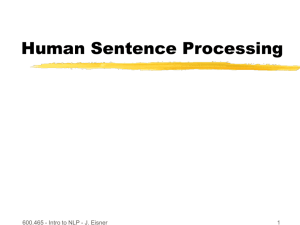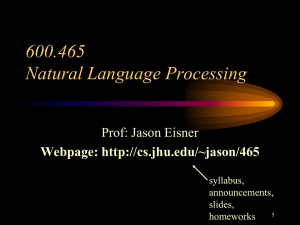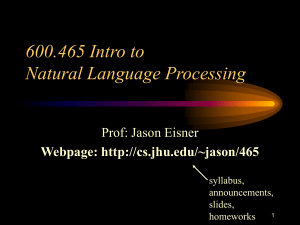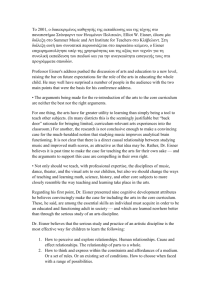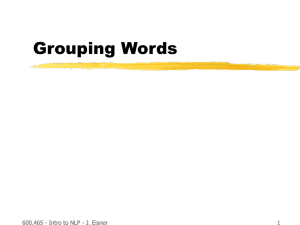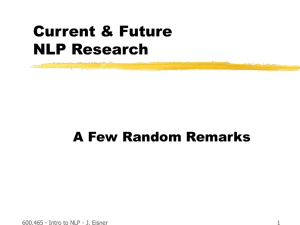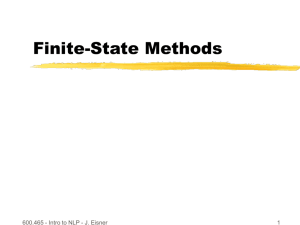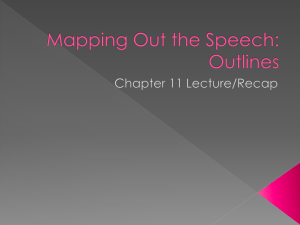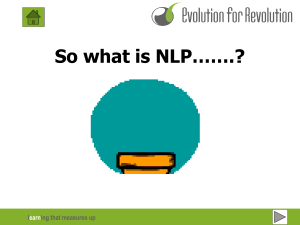HMM concepts
advertisement
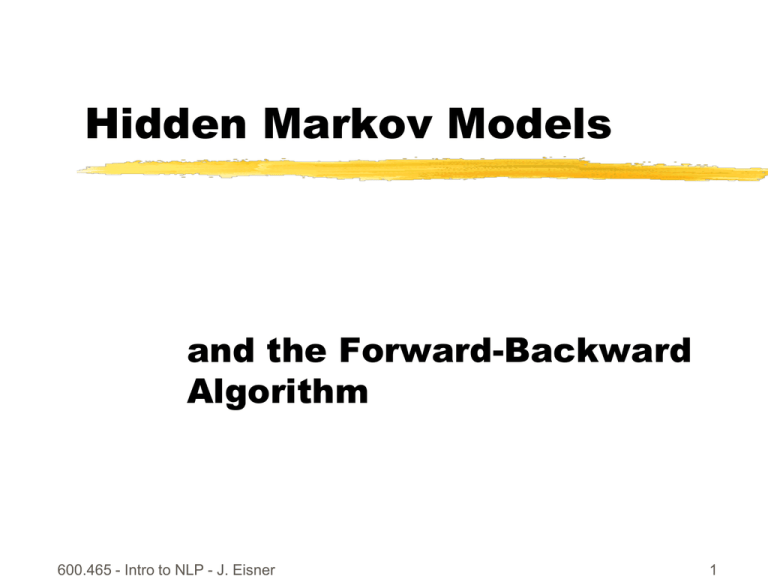
Hidden Markov Models
and the Forward-Backward
Algorithm
600.465 - Intro to NLP - J. Eisner
1
Please See the Spreadsheet
I like to teach this material using an
interactive spreadsheet:
http://cs.jhu.edu/~jason/papers/#tnlp02
Has the spreadsheet and the lesson plan
I’ll also show the following slides at
appropriate points.
600.465 - Intro to NLP - J. Eisner
2
Marginalization
SALES
Jan
Apr
…
Widgets
5
0
3
2
…
Grommets
7
3
10
8
…
Gadgets
0
0
1
0
…
…
…
…
…
…
…
600.465 - Intro to NLP - J. Eisner
Feb Mar
3
Marginalization
Write the totals in the margins
SALES
Jan
Apr
…
TOTAL
Widgets
5
0
3
2
…
30
Grommets
7
3
10
8
…
80
Gadgets
0
0
1
0
…
2
…
…
…
…
…
…
TOTAL
99
25 126
90
600.465 - Intro to NLP - J. Eisner
Feb Mar
Grand total
1000
4
Marginalization
Given a random sale, what & when was it?
prob.
Jan
Apr
…
TOTAL
0 .003 .002
…
.030
Grommets .007 .003 .010 .008
…
.080
.002
Widgets .005
Feb Mar
Gadgets
0
0 .001
0
…
…
…
…
…
…
…
TOTAL .099 .025 .126 .090
600.465 - Intro to NLP - J. Eisner
Grand total
1.000
5
Given a random sale, what & when was it?
Marginalization
joint prob: p(Jan,widget)
prob.
Jan
Apr
…
TOTAL
0 .003 .002
…
.030
Grommets .007 .003 .010 .008
…
.080
.002
Widgets .005
Feb
Mar
Gadgets
0
0 .001
0
…
…
…
…
…
…
…
TOTAL .099 .025 .126 .090
marginal prob: p(Jan)
600.465 - Intro to NLP - J. Eisner
marginal
prob:
p(widget)
1.000
marginal prob:
p(anything in table)
6
Given a random sale in Jan., what was it?
Conditionalization
Divide column
through by Z=0.99
so it sums to 1
joint prob: p(Jan,widget)
Apr
…
TOTAL
p(… | Jan)
0 .003 .002
…
.030
.005/.099
Grommets .007 .003 .010 .008
…
.080
.007/.099
.002
0
prob.
Jan
Widgets .005
Feb
Mar
Gadgets
0
0 .001
0
…
…
…
…
…
…
…
TOTAL .099 .025 .126 .090
…
1.000
.099/.099
marginal prob: p(Jan)
conditional prob: p(widget|Jan)=.005/.099
600.465 - Intro to NLP - J. Eisner
7
Marginalization & conditionalization
in the weather example
Instead of a 2-dimensional table,
now we have a 66-dimensional table:
33 of the dimensions have 2 choices: {C,H}
33 of the dimensions have 3 choices: {1,2,3}
Cross-section showing just 3 of the dimensions:
Weather2=C
Weather2=H
IceCream2=1
0.000…
0.000…
IceCream2=2
0.000…
0.000…
IceCream2=3
0.000…
0.000…
600.465 - Intro to NLP - J. Eisner
8
Interesting probabilities in
the weather example
Prior probability of weather:
p(Weather=CHH…)
Posterior probability of weather (after observing evidence):
p(Weather=CHH… | IceCream=233…)
Posterior marginal probability that day 3 is hot:
p(Weather3=H | IceCream=233…)
= w such that w3=H p(Weather=w | IceCream=233…)
Posterior conditional probability
that day 3 is hot if day 2 is:
p(Weather3=H | Weather2=H, IceCream=233…)
600.465 - Intro to NLP - J. Eisner
9
The HMM trellis
The dynamic programming computation of a works forward from Start.
Day 1: 2 cones
Day 2: 3 cones
Day 3: 3 cones
a=0.1
a=1
C
a=0.1*0.08+0.1*0.01
a=0.009*0.08+0.063*0.01
=0.009
=0.00135
p(C|C)*p(3|C)
p(C|C)*p(3|C)
C
C
0.8*0.1=0.08
0.8*0.1=0.08
Start
H
a=0.1
p(H|H)*p(3|H)
p(H|H)*p(3|H)
H
H
0.8*0.7=0.56
0.8*0.7=0.56
a=0.1*0.07+0.1*0.56
a=0.009*0.07+0.063*0.56
=0.063
=0.03591
This “trellis” graph has 233 paths.
These represent all possible weather sequences that could explain the
observed ice cream sequence 2, 3, 3, …
What is the product of all the edge weights on one path H, H, H, …?
Edge weights are chosen to get p(weather=H,H,H,… & icecream=2,3,3,…)
What is the a probability at each state?
It’s the total probability of all paths from Start to that state.
How can we compute it fast when there are many paths?
600.465 - Intro to NLP - J. Eisner
10
Computing a Values
a
a1
a
a
b
c
d
a2
e
f
p1
C
All paths to state:
= (ap1 + bp1 + cp1)
+ (dp2 + ep2 + fp2)
C
p2
H
= a1p1 + a2p2
Thanks, distributive law!
600.465 - Intro to NLP - J. Eisner
11
The HMM trellis
The dynamic programming computation of b works back from Stop.
Day 33: 2 cones
Day 34: lose diary
Day 32: 2 cones
b=0.16*0.1+0.02*0.1
b=0.16*0.018+0.02*0.018
=0.018
=0.00324
p(C|C)*p(2|C)
p(C|C)*p(2|C)
C
C
0.8*0.2=0.16
0.8*0.2=0.16
b=0.1
C
Stop
p(H|H)*p(2|H)
p(H|H)*p(2|H)
H
0.8*0.2=0.16
0.8*0.2=0.16
b=0.16*0.1+0.02*0.1
b=0.16*0.018+0.02*0.018
=0.018
=0.00324
H
H
b=0.1
What is the b probability at each state?
It’s the total probability of all paths from that state to Stop
How can we compute it fast when there are many paths?
600.465 - Intro to NLP - J. Eisner
12
Computing b Values
b
All paths from state:
= (p1u + p1v + p1w)
+ (p2x + p2y + p2z)
C
p1
C
p2
= p1b1 + p2b2
600.465 - Intro to NLP - J. Eisner
H
u
v
w
b1
b
x
y
z
b2
13
Computing State Probabilities
All paths through state:
ax + ay + az
+ bx + by + bz
+ cx + cy + cz
a
a
b
c
C
x
y
z
b
= (a+b+c)(x+y+z)
=
a(C)
b(C)
Thanks, distributive law!
600.465 - Intro to NLP - J. Eisner
14
Computing Arc Probabilities
All paths through the p arc:
apx + apy + apz
+ bpx + bpy + bpz
+ cpx + cpy + cpz
C
a
a
b
c
p
x
y
z
b
H
= (a+b+c)p(x+y+z)
=
a(H)
p
b(C)
Thanks, distributive law!
600.465 - Intro to NLP - J. Eisner
15
Posterior tagging
Give each word its highest-prob tag according to
forward-backward.
Do this independently of other words.
Det Adj
0.35 exp # correct tags = 0.55+0.35 = 0.9
exp # correct tags = 0.55+0.2 = 0.75
Det N
0.2
N V
0.45 exp # correct tags = 0.45+0.45 = 0.9
Output is
Det V
0
exp # correct tags = 0.55+0.45 = 1.0
Defensible: maximizes expected # of correct tags.
But not a coherent sequence. May screw up
subsequent processing (e.g., can’t find any parse).
600.465 - Intro to NLP - J. Eisner
16
Alternative: Viterbi tagging
Posterior tagging: Give each word its highestprob tag according to forward-backward.
Det Adj
Det N
N V
0.35
0.2
0.45
Viterbi tagging: Pick the single best tag sequence
(best path):
N
V
0.45
Same algorithm as forward-backward, but uses a
semiring that maximizes over paths instead of
summing over paths.
600.465 - Intro to NLP - J. Eisner
17
Max-product instead of sum-product
Use a semiring that maximizes over paths instead of summing.
We write , instead of a,b for these “Viterbi forward” and “Viterbi
backward” probabilities.”
The dynamic programming computation of . (u is similar but works back from Stop.)
Day 1: 2 cones
Day 2: 3 cones
Day 3: 3 cones
=0.1
C
=max(0.1*0.08,0.1*0.01) =max(0.008*0.08,0.056*0.01)
=0.008
=0.00064
p(C|C)*p(3|C)
p(C|C)*p(3|C)
C
C
0.8*0.1=0.08
0.8*0.1=0.08
Start
H
=0.1
p(H|H)*p(3|H)
p(H|H)*p(3|H)
H
H
0.8*0.7=0.56
0.8*0.7=0.56
=max(0.1*0.07,0.1*0.56) =max(0.008*0.07,0.056*0.56)
=0.056
=0.03136
a*b at a state = total prob of all paths through that state
* at a state = max prob of any path through that state
Suppose max prob path has prob p: how to print it?
Print the state at each time step with highest * (= p); works if no ties
Or, compute values from left to right to find p, then follow backpointers
600.465 - Intro to NLP - J. Eisner
18

